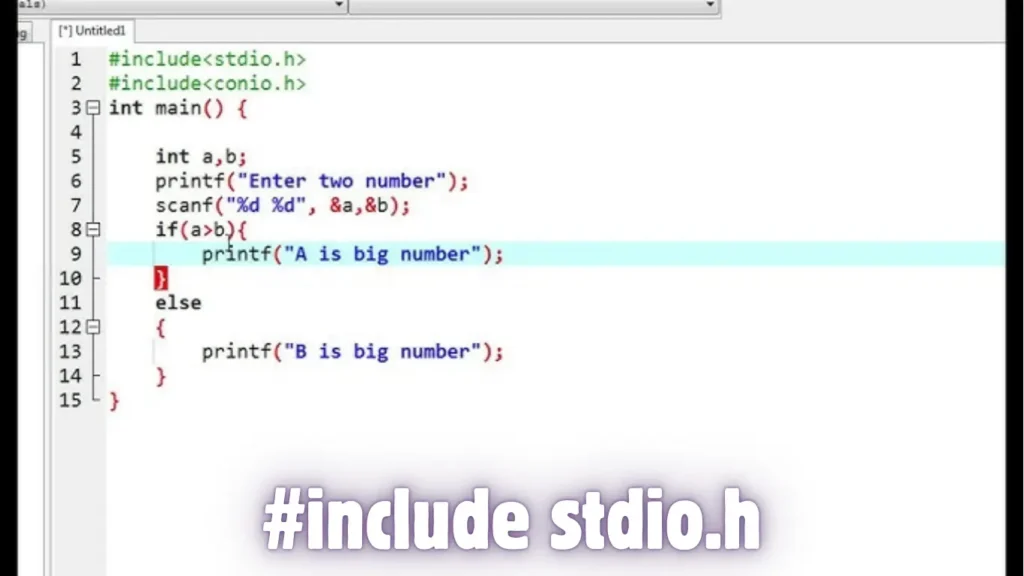In C programming, #include stdio.h is fundamental. This header file, part of the C standard library, unlocks the essential functions you need for input-output operations. Let’s explore why stdio.h is vital and how it enables you to build robust programs with ease.
What Is #include <stdio.h>?
The #include stdio.h directive in C includes the Standard Input-Output library. As part of C’s core structure, it provides access to critical functions like printf for output and scanf for input. By including this file, you streamline operations for reading and displaying data, creating a seamless user experience in C applications.
Why Do We Use #include <stdio.h>?
Using #include stdio.h enables the C compiler to locate essential functions and symbols for handling input-output. Here’s why it matters:
- Enables Data Interaction: Use
printfandscanfto interact with users, guiding data into and out of the program smoothly. - Provides Standardized Commands: With functions like
getcharandputchar,stdio.hbrings consistency across different C compilers. - Supports File Handling: The library includes tools for file handling in C, making it easy to read from and write to files.
How to Include stdio.h in Your Program
In C, including stdio.h is straightforward:
#include <stdio.h>This simple line informs the preprocessor to load the stdio.h file. Whether creating complex applications or basic programs, this inclusion is indispensable for input-output operations.
Key Functions of #include stdio.h
1. Output with printf
The printf function allows you to display text and variables on the screen:
printf("Hello, World!");It is versatile for formatting outputs, making it invaluable for user-friendly displays. printf accepts various placeholders (%d, %s, etc.), letting you precisely control how data appears.
2. Input with scanf
The scanf function reads data entered by the user:
scanf("%d", &variable);By using format specifiers, scanf ensures that data is processed correctly, guiding efficient program interaction.
3. Character Input and Output
Getchar and putchar handle single-character inputs and outputs, ideal for simple commands or interfaces:
char ch;
ch = getchar();
putchar(ch);They’re often useful in character-based applications or menu-driven programs, where user input influences control flow.
Advanced Functions in stdio.h
Beyond printf and scanf, stdio.h offers functions like fgets and fputs for file handling. These functions provide more control for handling user data effectively.
1. File Handling with fopen, fclose, fread, and fwrite
Working with files becomes straightforward:
FILE *file = fopen("filename.txt", "r");
fclose(file);These functions help in storing data between program executions, essential for data persistence.
2. Error Handling with perror and ferror
The perror function displays custom error messages, guiding users if issues arise:
perror("File Error");It builds trust in applications by addressing user concerns transparently.
Benefits of Using #include stdio.h
- Reliable Input-Output Functions: Whether displaying results or collecting data,
stdio.hensures smooth, consistent interactions. - Cross-Platform Consistency:
stdio.haligns with standardized commands, making your code more portable. - Ease of Debugging: With functions like
perror, you can handle errors effectively, enhancing code reliability. - Flexibility for Developers: The range of input-output functions allows for creative and user-friendly applications.
Common Errors When Using stdio.h
- Forgetting to Include
#include <stdio.h>: This leads to undefined references. - Incorrect Format Specifiers in
printforscanf: Always match data types to prevent runtime errors. - Mismanaging File Pointers: Remember to close files with
fcloseto prevent data corruption.
Optimizing stdio.h Functions for User Experience
Consider using stdio.h functions strategically:
- Printf for Clear Communication: Use precise formatting to avoid ambiguity in output.
- Scanf with Validation: Check user input to prevent errors, enhancing the user experience.
- File Operations with Data Integrity: Ensure files are handled carefully to avoid data loss or corruption.
FAQs
Why is #include stdio.h necessary in C programs?
#include <stdio.h> enables input-output functionality essential for C programs, allowing users to interact meaningfully with applications.
Can I use C without stdio.h?
While possible, it limits interaction capabilities since printf, scanf, and file handling depend on stdio.h.
What is the purpose of printf and scanf?
printf displays output, and scanf reads user input, both crucial for interactive programs.
How do I manage files in C using stdio.h?
Use functions like fopen and fclose to read from and write to files. These allow data preservation across program executions.
What are common issues with stdio.h functions?
Errors like mismatched format specifiers or forgetting to close files can lead to program malfunctions.
Conclusion
In conclusion, #include stdio.h is a cornerstone of C programming, empowering developers with efficient tools for input-output operations. This powerful library enables programs to interact with users through text, character data, and file management. Whether you’re displaying information with printf, gathering user input with scanf, or managing files, stdio.h provides a robust set of functions that make programming in C both practical and reliable.
Mastering stdio.h functions not only enhances your coding skills but also opens up endless possibilities for creating user-friendly applications. By using these tools effectively, you can write dynamic, interactive programs that offer a smooth, intuitive experience for end-users. Embrace the capabilities of stdio.h in your projects, and you’ll find it an invaluable asset in your programming journey.


